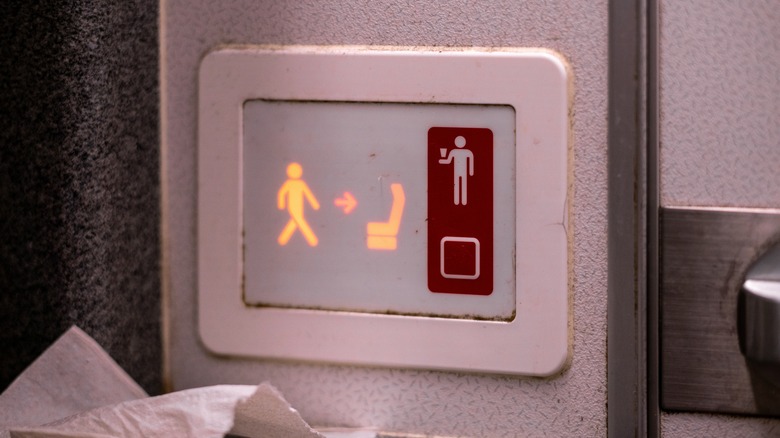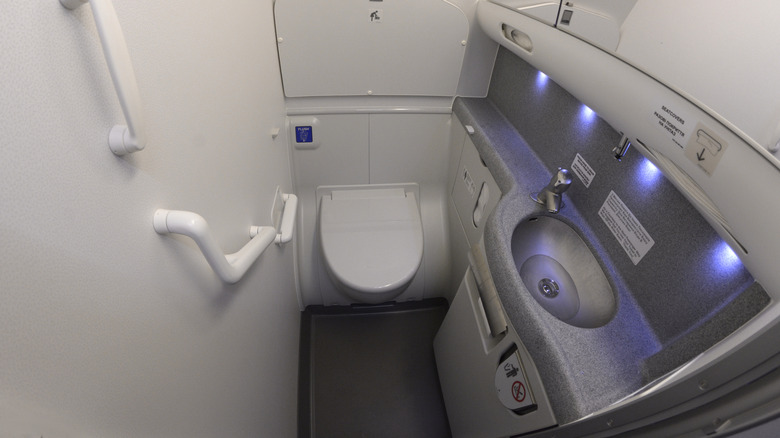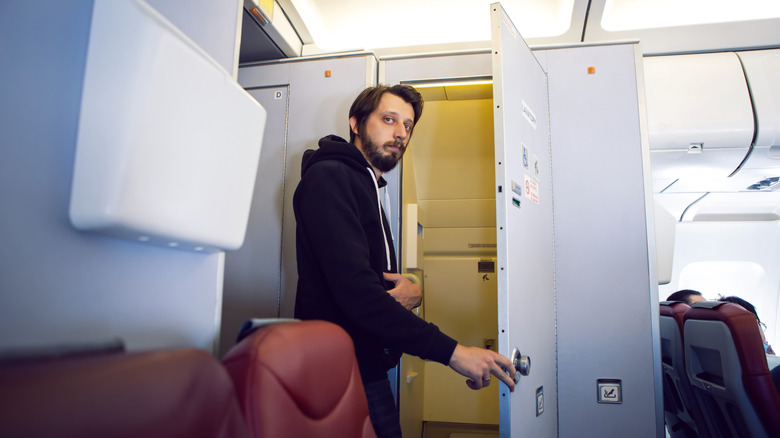The Best Thing To Do If You're In The Plane Bathroom And Turbulence Strikes
Imagine you're mid-flight, tucked away in the airplane bathroom, doing your business (or a multi-step long-haul flight skincare routine) when suddenly, the plane begins to shake violently. Horrible timing? No kidding. The seatbelt sign is illuminated, and you feel the aircraft lurch as it hits intense turbulence. What do you do? To answer this question, Explore reached out to Barbi, a journalist and veteran flight attendant with nearly 40 years of experience with a major U.S. airline, for an exclusive interview.
The most important piece of advice Barbi offers is this: Stay put and resist the urge to rush back to your seat. "When intense or severe turbulence strikes, as my airline classifies it, the best thing to do is stay where you are," she advises. Even if that means staying in the often smelly and cramped plane bathroom. The impulse to return to the safety of your seat is understandable, but walking through the cabin during severe turbulence is not only difficult (even for pro flight attendants), it's dangerous.
Airplane turbulence comes in four levels and can range from light (marked by slight erratic movements) to extreme (when the aircraft is shaking uncontrollably and is nearly impossible to operate). "If a flight attendant needs to take their jump seat due to turbulence, there is no way a passenger should even attempt to walk back to their seat," Barbi cautions. Passengers should not attempt to move to prevent injuries — FAA reports 184 fliers have been seriously hurt by turbulence since 2009.
How to protect yourself while in the bathroom
If you find yourself stuck in the bathroom during turbulence, there are a few strategies you can use to minimize the risk of injury. Barbi draws on her diverse experiences as a flight attendant, former barrel racer, and boat owner — what a triple threat! — to offer some practical advice. "When the surface you're standing on is shifting dramatically, take a wide stance and keep your knees soft while holding on to something," she recommends. This stance will help you maintain your balance, even as the plane sways and swishes unpredictably. After all, there are no seatbelts in the lavatory.
In the confined space of an airplane bathroom, this might mean gripping the sink, counter, or any other stable surface you can find (all spots you shouldn't touch on an airplane, but when crisis strikes, you gotta do what you gotta do!). If the turbulence is particularly severe, sitting down on the closed toilet may be your best option. This position lowers your center of gravity and reduces the likelihood of being turbulently thrown around the small space. However, as Barbi notes, the best position does depend on your size and personal strengths.
When to leave the airplane bathroom
Although airplane turbulence is less of a big deal than it feels, you shouldn't just leave the bathroom in the intense thick of it. Knowing when it's actually safe to return to your seat is crucial. "Only when the cabin crew tells you it is safe to do so," Barbi advises. This usually happens when the turbulence subsides, and the crew deems it safe for passengers to move around the cabin. A signal that leaving the lavatory is safe is when the seatbelt sign is off, and the crew gives an all-clear.
If you're dealing with moderate or mild turbulence, it might be better to make your way back to your seat as quickly and safely as possible. Barbi recommends a cautious approach: "Walking in the cabin and placing your hands on the overhead bins using a hand-over-hand method can help stabilize you as you make your way back to your seat." This technique, used by flight attendants, allows you to brace against the plane's movements and prevent the risk of losing your balance and falling.
Barbi's 40 years in the skies have given her a first-hand perspective on the importance of safety during flights. Turbulence is an unpredictable and unavoidable aspect of air travel, but knowing how to react can make all the difference, especially for people who have flying anxiety. In this case, the best course of action is to stay where you are, protect yourself, and listen to the crew's instructions.


